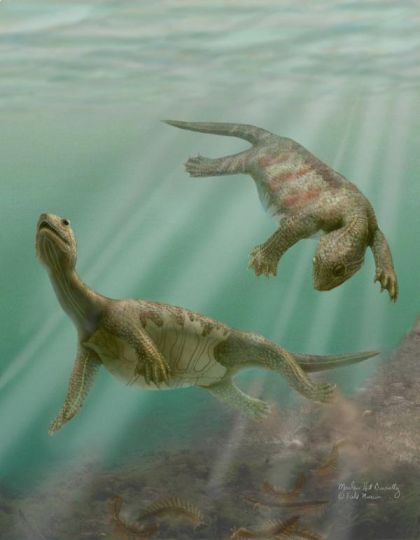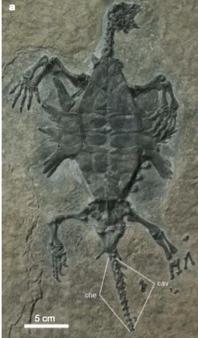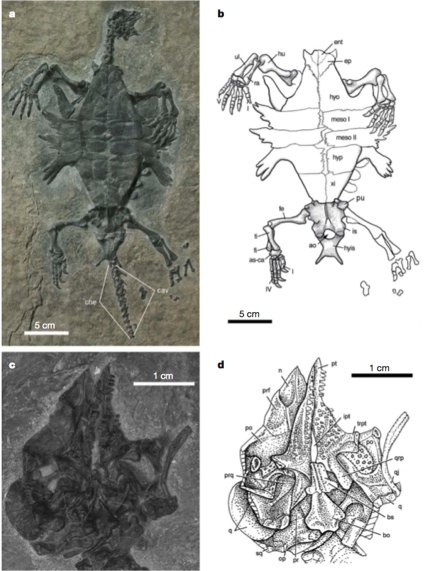Who were the first turtles - water turtles or land turtles? This is what two new studies published last week are trying to answer, which dealt with turtle fossils that are 204-220 million years old

Turtles are quite strange animals. At first glance, it seems that the animal lives inside an outer shell - hence, of course, the saying about the turtle that "carries its home on its back". At a second look, however, it turns out that the armor is an integral part of the animal's body, and literally consists of its bones - its ribs, part of the shoulder bones, and more.
The outer part of the armor consists of special scales, which originate from the skin of the turtle. The lower part of the turtle is covered with armor, known as a chest shield or plastron, and is connected to the back armor by "bridges" of bone. The advantages that hard armor gives to the animal are self-evident, but with them also come disadvantages - apart from the famous slowness of the turtle, the peculiar structure also required a special adaptation of its way of breathing - most reptiles inhale air by moving the ribs and expanding the chest (similar to mammals, but ours There is also a diaphragm, which expands the chest in a different way). The ribs fixed inside the shell are, of course, unable to move, so the turtle has developed a different system, in which the legs and head expand the thorax when they are pulled out of the shell.
Naturally, many hypotheses were raised regarding the development of such a strange creature. Until now, the oldest fossils that could be identified as primitive turtles came mainly from Germany. The species Proganochelys quenstedti lived about 204 to 206 million years ago, and unlike modern, toothless turtles, the Proganochelys kept their teeth in the upper part of their mouths. These turtle-like creatures had not only impressive back armor but also special armor, covered with spines, on the neck and tail. The accepted theory, therefore, is that the ancient turtles were relatives of extinct reptiles called Pareiasaurus, which had a magnificent leather "armor".

Last week, an article was published in Nature magazine that revealed even older fossils, found near Guanling in Guizhou Province, China. Chen Li (Li) from the Academy of Sciences in Beijing, together with other scientists from China, Canada and the United States, describe in an article a new species of primitive turtle, Odontochelys semistacea, which lived about 220 million years ago. Its name means "toothed turtle", since this species had a complete set of teeth - so in this respect they are more primitive than Prognochelys. Fortunately, the two fossils that were found have been preserved so that one of them is lying on its stomach, and its back can be clearly seen, while the other is located upside down - from which one can learn what the stomachs of these creatures looked like.
The Odontochelys may be able to shed new light on the evolution of turtles, as they appear to be a sort of intermediate form between modern turtles and more "conventional" reptiles - they have a modern looking plastron, but their back armor is very underdeveloped - the ribs look broad and flat, like a turtle Modern, but they are not part of a complete armor. In fact, they resemble the ribs of a turtle embryo, before the shell itself is formed. Another fundamental difference between the two species of primitive turtles was their habitat - Prognochelys was apparently a land turtle, but various signs indicate that Odontonchelys lived in the sea: the fossils were found in a layer of marine sediments, and they had long legs that characterize marine turtles.
The researchers concluded that Odontochelys is the most primitive version of turtle-like reptiles known today, and therefore, that the evolution of turtles began in the sea - first sea turtles developed, with a developed chest shield but only the beginnings of a back armor, and then the modern water turtles and land turtles - contrary to what was commonly thought until today. The fact that the chest shield is much more essential for sea turtles, whose bellies are exposed to predators swimming below them, than for land turtles whose bellies are close to the ground, further strengthens this theory. Instead of pareosaurs, researchers now associate the ancient turtles with another group of reptiles - the Diapsid, which includes lizards, snakes and crocodiles.
However, there are paleontologists who disagree with Lee and his colleagues. In the same issue of Nature, two researchers from the University of Toronto in Canada, Robert Reisz and Jason Head, offered another interpretation for the fossils found. They argue that the Odontochelys may not represent an ancient stage, but a local adaptation of a certain species of turtle to life in the sea. The researchers base their theory on observing the differences between land turtles and water turtles living today - while the land turtles have a hard shell, there are many water turtles with a softer shell (there is a group of freshwater turtles that are called "soft turtles"). These turtles have a full shell, but not all bony - that is, parts of land turtles are composed of bone, they are composed of softer materials.
The researchers say that Odontochelys may very well have had a full but soft carapace, similar to modern water turtles, and because the soft parts are not fossilized, the fossil found appears to have only been partially carapaced. To strengthen their theory, the researchers bring the bone "bridges" found in the fossils, which are very similar to the bridges connecting the plastron to the carapace in modern turtles - this is indirect evidence of the existence of a complete carapace in Odontochelys as well.

If this theory is correct, the turtles did not develop in an aquatic environment, and Odontochelys is not a very primitive version of a turtle, but a descendant of a land turtle with a full and hard shell, which moved to live in water and consequently changed the composition of the shell. One of the problems with the theory is that it includes the development of armor in an earlier species and then partial loss of it, so it is seemingly more complicated than the competing theory, which includes small steps of armor development, without "going back". The researchers try to overcome this problem with the claim that a simple stop of the acclimation process during the embryonic development of the turtle could lead to the situation they describe. Since denaturation is the last stage in the formation of the armor in the embryos of modern turtles, it is a relatively simple step, which does not require the introduction of new developmental processes but only the maintenance of an earlier developmental state.
In conclusion, it seems that the discovery of the fossils, more than answering the question of the origin of the turtles, raised more questions and new debates. It is possible that only discoveries of fossils of a new, even more ancient species will be able to settle the dispute.

6 תגובות
Teenage Mutant Ninja Turtles
Everything is written, and science is unnecessary.
Just remind me please what day were the bacteria and viruses created ????
That's it and that's it - don't let the facts ruin your theory...
Maybe the ninja turtles were created by God before 5776 or some year..
Not as Pharaoh, they were created according to the counting of the Jews =]
For the purpose you have a mistake they were created in 5776 BC
bullshit!!!!
Everyone knows that the turtles were created on the third day (both the water turtles and the land turtles) exactly 5776 years ago.
Evolution is an invention of infidels and heathens who try to confuse people with nonsense in order to keep them away from religion.
That's it and that's it!!!